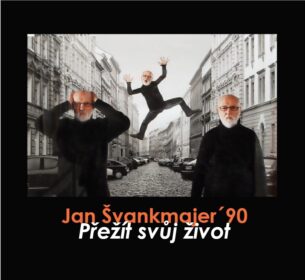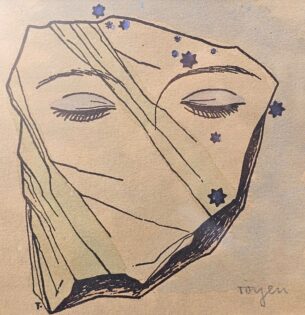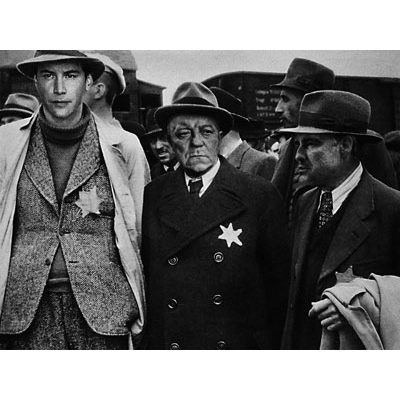Pavel M. Smejkal
Pavel Maria Smejkal: STARS
(9. 11. – 30. 11.2013)
Historické fotografie v nové digitální úpravě jako sugestivní připomínka aktuálnosti hrůz holocaustu.
kurátorka: Nadia Rovderová
text: Věra A. Tydlitátová, Nadia Rovderová, Pavel Maria Smejkal
vernisáž: sobota 9. 11. 2013, 18 h.
sledujte událost na Facebooku:
UDÁLOST: https://www.facebook.com/events/359143950897428/
FOTOGRAFIE: https://www.facebook.com/media/set/?set=a.550975194975173.1073741839.100551130017584&type=3
po otevření výstavy v klubu galerie: Klezzy Duo sourozenců Michala Kostiuka (klarinet) a Pavly Přerovské (klavír), židovské melodie.
STARS je název souboru, který Pavel Maria Smejkal vytvořil na základě fotografií z tzv. Auschwitz alba a záběrů pořízených Američany během osvobozování koncentračních táborů. Tváře obětí pomocí digitálních úprav vyměnil za tváře slavných „hvězd“, lidí, jenž představují symbol úspěchu a využití lidského potenciálu. Mohli by se tito lidé za jistých okolností dostat do podobné situace? Mohli bychom se do ní dostat vy či já? Jak zabránit tomu, aby takové situace nastaly? Je zárukou vzdělání, životní úroveň? Existují vůbec nějaké záruky?
Výstavu otevřeme v den 75. výročí událostí známých pod názvem „Kristallnacht“. V noci z 9. na 10. 11. 1938 v Německu vypukl protižidovský pogrom. „Křišťálová noc“ se mu říká podle rozbitých oken a výloh židovských domů, obchodů, synagog… Onu noc zahynula téměř stovka Židů, poté jich bylo 30 000 deportováno do koncentračních táborů. Vhodnějším názvem než „křišťálová noc“ se jeví termín „Říšský pogrom“ – akce byly totiž říšskými úřady vyprovokované a podněcované. Pogrom se rozhořel ve vyspělém, moderním státě a byl spáchaný příslušníky národa, jenž se pyšnil skvělými filosofy, spisovateli, skladateli a vědci. Vyhlazování části obyvatelstva se uskutečnilo za pomoci výdobytků vědy a techniky a bylo provedeno s maximální precizností.
Od začátku 2. světové války uplynulo tři čtvrtě století – ta doba je dnes pro většinu z nás historií. Je naše doba chráněna před působením chaosu, zla a nespravedlností posvěcených z nejvyšších míst? Zvěrstva, jenž se děly v průběhu 2. světové války nebyly výjimečné – pokusů o vyhlazení jistých společenství najdeme v historii lidstva nespočet. Nemůžeme to považovat za hrůznou anomálii, naopak – máme hodně předpokladů se domnívat, že se tento jev vyskytuje opakovaně a můžeme s ním tudíž počítat i do budoucna. Ani naše společnost není chráněna. Navenek je vše v pořádku – neprobíhají tu státní pogromy, lidé mají jiné starosti, než je ohrožení spoluobčanů, a varování se zdají přehnaná. Ale kdesi na okraji se chaos již ohlašuje poničenými hřbitovy, pochody okolo synagog, protiromskými demonstracemi, vzrůstající agresivitou v médiích, na internetu.
Před několika lety by antisemitské výroky česká společnost rychle a jednoznačně zavrhla. Čtvrt století po listopadu 1989, který ukončil dobu, kdy byli protižidovské výpady doménou bolševických kádrů, jsou opět antisemitské výroky bagatelizovány a stávají se běžnou součástí společenského diskursu. Při pohledu na některé internetové diskuse se veškeré iluze o vysoce vzdělaném a kulturním lidu naší země rozpouštějí ve smršti široce sdílených výlevů nenávisti vůči menšinám, nejvíce opět vůči Židům a Romům. Adam B. Bartoš – autor řady protižidovských výpadů, pomluv, urážek, seznamů nepřátel a paranoidních konstrukcí, dokázal ovlivnit volbu prezidenta – Zemanův tým informace z Bartošových textů využíval. Paradoxně z antisemitismu obvinil Karla Schwarzenberga a jeho manželku – prý v sídle, kde pobývá, dosud visí obrazy s hákovými kříži a hajlujícími lidmi. Ukázalo se, že sídlo rodině nepatří už 300 let. (http://www.ostrava-online.cz/tema/tema-tak-tohle-uz-je-moc-na-hrade-schwarzenbergovy-manzelky-se-hajluje). Miloš Zeman se musel omluvit, Adam B. Bartoš se však jako věrný služebník zúčastnil 28. 10. 2013 oslav dne státnosti na pražském Hradě.http://zpravy.e15.cz/domaci/udalosti/misto-rektoru-akce-d-o-s-t-na-hrad-dorazil-kontroverzni-novinar-a-b-bartos-1033406. Tento agilní bloger však u nás není jediným aktivním antisemitou. Ekonomická, společenská a morální krize se prohlubuje a přibývá autorů a textů, za něž by se nemusel stydět ani Julius Streicher, nacistický pohlavár a vydavatel propagandistického bulváru Der Stürmer. Ostatně Der Stürmer opět vychází na internetu a i v češtině! Jestliže se dnes šíří slovní špína stejně jako před Říšským pogromem, je nutné, aby ti, kdo mají svědomí a odvahu, odkázali šiřitele nenávisti na jejich místo – mimo veřejný prostor. Antisemitismus potažmo rasizmus není názor, je to zločin!
Výstavou STARS chceme upozornit na smutnou aktuálnost hrůz holocaustu, na současnou hrozbu antisemitizmu a potažmo rasizmu. Ptáme se: Dalo se holocaustu a jemu podobným událostem v historii lidstva zabránit? Je možné, že se podobné situace musí v historii lidstva opět opakovat?
Pavel Maria Smejkal (* 1957, Ostrava).
Vystudoval Veterinární univerzitu v Košicích /1983/ a Institut tvůrčí fotografie na Slezské Univerzitě v Opavě /MgA. 2009/. Od r. 1989 je na volné noze – momentálně jako fotograf, grafik a kurátor. Pokračuje v doktorandském studiu na ITF.
O původu originálů historických fotografií použitých v sérii:
V cyklu STARS byly použité fotografie z tzv. Auschwitz alba, doplněné o záběry amerických vojenských fotografů, (např. Margarett Bourke-White) pořízených po osvobození koncentračních táborů (např. Buchenwald). Tzv. Auschwitz album bylo nalezeno náhodou v r. 1945 v kredenci v kasárnách SS v německém táboře Nordhausen-Dora bývalou vězenkyní, která se na některých záběrech poznala. Album patří k výjimečným dokladům dokumentujícím provoz táborů, nic podobného se v takovém rozsahu nezachovalo. Obsahuje 193 fotografií, autory jsou s největší pravděpodobností Ernst Hoffmann a/anebo Berhard Walter, jenž měli na starosti portrétování vězňů. Album zachycuje maďarské transporty na začátku leta 1944, výstup z transportu, selekční proces nastoupených vězňů a práci s množstvím šatstva a batožin. Co činí toto album ještě výjimečnější, je nález dalšího alba ze stejného tábora, jenž byl soukromým osobním „památečním“ albem důstojníka SS a zástupce velitele tábora Karla-Friedricha Höckera a jenž je unikátním svědectvím o živote personálu tohoto koncentračního tábora. Bylo pořízen v té samé době jako tzv. Auschwitz album a na veřejnost se dostalo až v r. 2007! Obsahuje 116 fotografií a zobrazuje personál, včetně doktora Mengeleho, při nejrůznějších událostech jako otevírání nemocnice, oslavy, Vánoce, či trávení volných chvil na chatě Solahütte jen pár kilometrů od koncentračního tábora.
——————————————————————————————————————–
ENGLISH:
Pavel Maria Smejkal: STARS
(9-30 November 2013)
Artinbox Gallery, Perlová 3, Prague 1, www.artinbox.cz
Digitally altered historical photographs as a vivid reminder of the horrors of the Holocaust.
curated by: Nadia Rovderová
text: Věra A. Tydlitátová, Nadia Rovderová, Pavel Maria Smejkal
opening: Saturday 9. 11. 2013, 18 h. / 6 p.m.
during the opening reception at the gallery’s club: Klezzy Duo – siblings Michal Kostiuk (clarinet) and Pavla Přerovská (piano), Jewish melodies.
Follow us on Facebook:
EVENT: https://www.facebook.com/events/359143950897428/
PHOTOGRAPHS: https://www.facebook.com/media/set/?set=a.550975194975173.1073741839.100551130017584&type=3
STARS is a series of works that Pavel Maria Smejkal has created using photographs from the “Auschwitz Album” and pictures taken by the Americans during the liberation of the concentration camps. The victim’s faces have been digitally replaced with the faces of famous “stars” – people who are symbols of success and the fulfillment of human potential. Under certain circumstances, could these people have ended up in a similar situation? Could it have been you or me? How can we prevent such situations from happening? Is education or standard of living a safeguard? Are there any safeguards?
The exhibition is being opened on the 75th anniversary of the events known as “Kristallnacht”. During the night from the 9th to the 10th of November 1938, an anti-Jewish pogrom erupted in Germany. The “Night of Broken Glass” received its name from the broken windows of Jewish homes, shops, and synagogues… That night, nearly a hundred Jews were killed and some 30,000 who were arrested were later sent to concentration camps. A more fitting name than “Kristallnacht” would be “Reichspogrom”, since the pogrom was provoked and encouraged by German officials. It erupted in a modern, advanced country and was committed against members of a nation that boasted outstanding philosophers, writers, composers, and scientists. The extermination of this population was carried out with the help of modern science and technology, and was performed with the utmost exactitude.
It has been three quarters of a century since the start of World War II – for most of us today, this era is ancient history. Is our own era safe from the effects of chaos, evil, and injustice consecrated from the highest places? The atrocities that were committed during World War II were no exception. Since human history contains countless attempts at exterminating certain groups of people, it cannot be called a horrible anomaly – in fact, there is plenty of reason to believe that this phenomenon appears repeatedly, meaning that we can expect it to occur in the future as well. Not even our society is safe. On the surface, all is in order: There are no state-guided pogroms and people have other worries than threatening their fellow citizens, so any warnings seem exaggerated. But on the margins, the coming chaos announces itself through damaged cemeteries, marches leading past synagogues, anti-Roma protests, and a growing level of aggressiveness in the media and on the internet.
Just a few years ago, Czech society would have quickly and clearly rejected any open expressions of anti-Semitism. A quarter century after the Velvet Revolution, which ended an era during which anti-Jewish attacks were the domain of communist party cadres, anti-Semitic statements are again played down and are becoming a regular part of social discourse. A glance at certain online discussion forums and their mass of hate-filled diatribes against minorities (as always, Jews and Roma) should dispel any illusions that we are a highly educated and cultured nation. Adam B. Bartoš – known for his many anti-Jewish diatribes, slanderous comments, insults, enemy lists, and paranoid constructions – even managed to influence the presidential election: Miloš Zeman’s team used information from Bartoš’s writings that, paradoxically, accused Karel Schwarzenberg and his wife of anti-Semitism. (Bartoš claimed that her family estate contained pictures of swastikas and people making “Sieg Heil” gestures, but in fact this “estate” hasn’t belonged to her family for 300 years.) (http://www.ostrava-online.cz/tema/tema-tak-tohle-uz-je-moc-na-hrade-schwarzenbergovy-manzelky-se-hajluje). Miloš Zeman had to apologize but Bartoš, ever the dutiful servant, attended the official celebration of the national holiday at Prague Castle on 28 October 2013.http://zpravy.e15.cz/domaci/udalosti/misto-rektoru-akce-d-o-s-t-na-hrad-dorazil-kontroverzni-novinar-a-b-bartos-1033406. This agile blogger is hardly our only anti-Semite, however. The economic, social, and moral crisis is deepening, and so we see more and more authors and texts that not even Nazi bigwig Julius Streicher, publisher of the propagandistic tabloid Der Stürmer, would have been ashamed of. In fact, Der Stürmer is today published online, even in Czech! When verbal garbage is being spread just as it was prior to the Reichspogrom, then people of conscience and courage must put the disseminators of hatred in their place – outside the public realm. Anti-Semitism and racism are not an opinion, but a crime!
With the current exhibition, we hope to call attention to the sad fact that the horrors of the Holocaust remain a current issue, and that anti-Semitism and racism represent a real threat today. We ask: Could the Holocaust and similar events in human history have been prevented? Is it possible that similar situations must repeat themselves in human history?
Pavel Maria Smejkal (* 1957, Ostrava).
Sejkal graduated from the Košice Veterinary University in 1983 and received an MA from the Institute of Creative Photography at Opava’s Silesian University in 2009. Self-employed since 1989, he today works as a photographer, graphic artist, and curator. He is currently studying for a doctorate from ICP.
On the origins of the historical photographs used in this series:
STARS uses photographs from the so-called Auschwitz Album, plus images taken by American military photographers (including Margaret Bourke-White) taken after the liberation of concentration camps such as Buchenwald. The Auschwitz Album was found by chance in 1945 in a dresser in the SS barracks in the German Nordhausen-Dora camp by a former prisoner, who recognized herself in some of the photographs. The album provides exceptional documentary evidence of the camps’ operations, since nothing similar of such scope survived the war. It contains 193 photographs probably taken by Ernst Hoffmann and/or Bernhard Walter, who were responsible for taking prisoners’ ID pictures. The album shows the arrival of the Hungarian transports in early summer 1944, the people emerging from the trains, the selection process, and the processing of large amounts of clothing and luggage. What makes this album even more exceptional today is the discovery of another album from the same camp. This album, which offers a unique witness of the life of the camp personnel, had been the personal album of SS officer and the camp’s adjunct commandant Karl-Friedrich Höcker. The pictures were taken around the same time as those from the Auschwitz Album, but the album was not made public until 2007! The album contains 116 photographs, mostly of camp personnel (including Dr. Mengele) at various events such as the opening of a hospital, festivities, Christmas, or relaxing at the “Solahütte” lodge located just a few kilometers from the camp.



